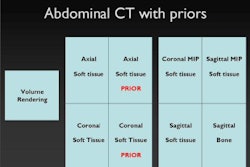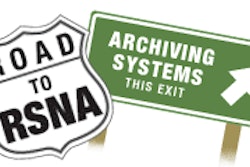Meeting the challenges of increased imaging utilization and reduced reimbursement for these procedures requires adopting healthcare information technology, in particular RIS and PACS, to maximize both efficiency and throughput. However, because radiology arguably touches almost all other areas of medical practice, it's no longer sufficient for PACS technology to be restricted to radiology.
Implementing PACS capabilities in perioperative and surgical services is very important from a workflow and efficiency standpoint, according to Timothy Sapyta, director of diagnostic imaging at Central DuPage Hospital in Winfield, IL
"PACS in the OR (operating room) cuts a lot out in terms of the number of touches on each record or a piece of film," he said.
Saptya shared his experiences providing PACS capabilities to a high-volume surgical department at the 2006 American Healthcare Radiology Administrators (AHRA) annual meeting in Las Vegas.
Central DuPage is a 321-bed community hospital that serves the suburban Chicago area. The facility's perioperative services comprises 24 operating suites that handle 15,600 surgical cases annually, giving it the third highest OR volume in Illinois and the highest volume of orthopedic surgery in the state, according to Sapyta.
Prior to the PACS implementation in the OR, the use of film in that department created a host of issues, Sapyta said. There were lost films, the wrong films showed up in the operating theater, the OR staff would spend their time sifting through multiple films looking for a particular image, required films would be signed out by someone else and would be unavailable, or the films were never returned or found in the OR.
"I know that in every OR situation there's sort of an abyss out there," Sapyta said. "I know I'm going to find this darkened room with stacks of film in it that no one has ever been able to locate and are deemed lost."
The use of film in an OR is labor-intensive, both prior to and after the surgical procedure. Prior to the operation, staff has to track down the requested films; afterwards the films have to be collected and returned to the film library.
When PACS was implemented in the radiology department, Sapyta's facility initially elected not to shift the OR to filmless status, believing that the technology would prove to be too disruptive to implement across all the departments needing access to diagnostic imaging. The institution decided to print out film copies of images for use by the OR, which turned out to be a waste of resources and labor. The only winner in this scenario was an extremely happy film vendor, Sapyta noted.
A key driver in implementing PACS capabilities in the OR was image access, Sapyta said. Central DuPage did not have a centralized film archive due to a lack of space. Film archives were distributed throughout the campus, and a great deal of labor was required to pull together all of a patient's images, he said.
The OR staff embraced the idea of PACS deployment in the department for a variety of reasons, chief among them being access to all of a patient's exams. In addition, surgeons were happy to have access to imaging tools such as window/level and measurements, during their procedures. The technology also provided them with quicker access to interoperative images, such as those provided by CR in the department. From the hospital's perspective, PACS OR adoption quickly slashed film costs for the service.
"The result was a $70,000 savings in film cost the first year by implementing PACS in the OR," Sapyta said.
There was, of course, an investment in infrastructure to deliver the technology to the OR. However, according to Sapyta, this was minimal when compared with the savings in film and labor. He noted that Central DuPage had to outfit each OR with a computer and monitors, but these were not $40,000 to $60,000 diagnostic reading workstations.
"If you look at the investment of hardware and wiring your hardware to the network versus the overall cost of the file room staff and the labor -- to us it was a no-brainer to do that," he said.
System success
Sapyta suggested that a facility should consider phasing in digital imaging technology to its other departments rather than a universal system-wide deployment. This allows other medical specialties a chance to gain a comfort level with the technology. For example, Central DuPage began extending the capabilities of PACS first to its emergency department. This gave surgeons an opportunity to view soft-copy images in use in a front-line department.
The PACS team also literally camped out in the surgeon's lounge for a week prior to implementation and demonstrated the system on various monitors and portable carts that were under consideration for deployment. The group held a monitor "bake off" for the OR nurses and surgeons so that they would have a chance to participate in the selection of technology that would be deployed in their department.
One of the greatest concerns of the surgical staff was the backup plan in place in case the system went down. Whereas other departments may be able to muddle through a 10-minute downtime, that was not an option for the OR. In case of a PACS failure, the OR immediately fails over to film, Sapyta said.
User policies for the OR -- sign-on process, access levels, and time-outs -- were created and signed off by the chief of surgery. Training was provided for all users of the system within the OR: nurses, surgeons, anesthesiologists, and OR technicians. In addition, Sapyta had members of his staff in the OR continually during the first two weeks of system deployment, providing assistance and demonstrating functionalities of the PACS.
"Don't start implementation too early and don't start implementation too late," Sapyta said. "Because if you start implementation too early, you may not get the comfort level; if you start implementation too late, the surgeons will get too used to using film."
By Jonathan S. Batchelor
AuntMinnie.com staff writer
August 29, 2006
Related Reading
3D penetrates trauma imaging niche, August 24, 2006
Radiology is dead -- long live imaging! June 23, 2006
Expanded role envisioned for imaging in autopsies, May 15, 2006
Radiology safety challenging in ER environment, March 5, 2006
US in the ICU: An essential tool in critical care treatment, February 3, 2006
Copyright © 2006 AuntMinnie.com



















